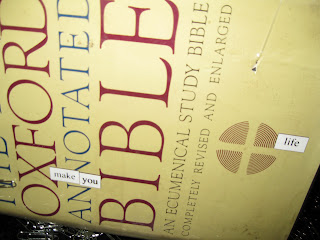On Sunday night, I hung four bibles from a ceiling and invited people to smash them together.
Why?
To make art! To make conversation! To make sacred text!
To clarify, this was at the Animamus Art Salon, the bibles were magnetized, and people wrote poetry on them.
Here's how it went down in 5 simple steps:
1. People would arrive at the art salon and notice bibles hanging from the ceiling above a table covered in paperclips and magnetic poetry
2. I would invite them to write a verse on the cover of one of the bibles using double-sided magnetic poetry (this is possible because the bibles were magnetic...because I glued magnets to the inside of their covers). I encouraged verses to be about what participants would include if they were to create their own sacred text.
3. Participants were then asked to document in a handy-dandy notebook what they wrote .
4. Participants then pulled back the bibles and smashed them into each other!
In the collision, some of the words of poetry would transfer from one bible to another, some would fall off, and some would stay where they started. But one way or another, the words that each person wrote physically connected to the words that someone else wrote, and were changed in the process. Which brings us to:
5. People examined what of the old remained and what new poetry had been created by comparing the covers of the post-collision bibles to what had been documented in the handy-dandy notebook.
(Click here for more pictures of this and the other amazing presenters at the salon)
I did this to start a conversation about how the Bible is not a single book written by a single author, it's a library. The Bible is a collection of texts written by different communities with very different views over the course of very different periods of history. As a result, the Bible conflicts with itself, contradicts itself, and contains everything from war stories, to erotic poetry, to nihilistic philosophy. And that's what makes it sacred. The Bible's holiness comes not from having an exclusive claim to truth, or even a consistent message about God, but from being the surface on which people throughout history have let loose their deepest, and often most broken, convictions about what it means to be human in search of the divine, and let those convictions collide. And in that collision of convictions, some have transferred, some have fallen away, and some have remained but were remade for future generations to smash into.
And so with this project, I invited people to do just that, to join the smashing, to join the colliding, to join the recreating of the sacred conversation throughout history.
(one of the bibles after it had collided four times)
.jpg)







No comments:
Post a Comment